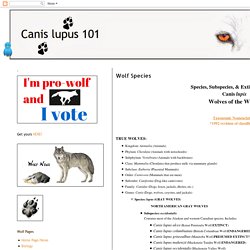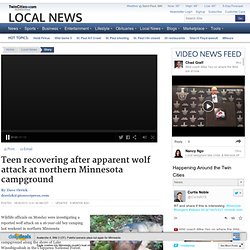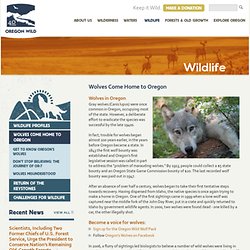

Blogging for the Gray Wolf. Wolf Species. Species, Subspecies, & Extinct Forms of Canis lupis Kingdom: Animalia (Animals)Phylum: Chordata (Animals with notochords)Subphylum: Vertebrata (Animals with backbones)Class: Mammalia (Chordates that produce milk via mammary glands)Subclass: Eutheria (Placental Mammals)Order: Carnivora (Mammals that eat meat)Suborder: Caniforma (Dog-like carnivores)Family: Canidae (Dogs, foxes, jackals, dholes, etc.)Genus: Canis (Dogs, wolves, coyotes, and jackals)Species: lupus (GRAY WOLVES)Subspecies: occidentalis Contains most of the Alaskan and western Canadian species.

Includes: Canis lupus alces (Kenai Peninsula Wolf-EXTINCT)Canis lupus columbianus (British Columbian Wolf-ENDANGERED)Canis lupus griseoalbus (Manitoba Wolf-PRESUMED EXTINCT?) Subspecies: albus Occurs throughout the Eurasian tundra and forest-tundra from Finland eastward to the Kamchaika Peninsula. Working For Wolf Conservation. Wolf Education Project. Living With Wolves. 'Apparent wolf attack': Campers say wolf tore through campground. Early Monday morning, an average-sized male wolf of about 75 pounds, matching the description of the wolf in the attack, was trapped and killed in the campground.

The wolf is being taken to the University of Minnesota veterinary diagnostic lab to be tested for rabies. Also, the lab will collect samples for DNA analyses and complete a thorough medical examination to determine the health of the animal. (Courtesy Department of Natural Resources) Wildlife officials on Monday were investigating a reported wolf attack on a 16-year-old boy camping last weekend in northern Minnesota The attack reportedly occurred early Saturday in a campground along the shore of Lake Winnibigoshish in the Chippewa National Forest. The teen, who was sleeping at the time, suffered nonlife-threatening cuts to his head and puncture wounds to his face.
If confirmed, it would be the first documented wolf attack of such severity in Minnesota and likely in the continental U.S. Here's what happened, according to Provost: How do Wolves Improve the Environment? Wolf Facts: Gray Wolves, Timber Wolves & Red Wolves. Wolves are large carnivores — the largest member of the dog, or Canid, family.

Wolves are common to all parts of the Northern Hemisphere. They are usually shy and cautious around humans but unlike the dog, have not been domesticated at all. A Man Among Wolves. Nature In The Wild-In The Comapny Of Wolves with Timothy Dalton Pt. 2. The World of Wild Wolves - part 1 series. TRUE WOLF OFFICIAL TRAILER. Wolf Picture. Wolves, Wolf Pictures, Wolf Facts. Wolves are legendary because of their spine-tingling howl, which they use to communicate.

A lone wolf howls to attract the attention of his pack, while communal howls may send territorial messages from one pack to another. Some howls are confrontational. Much like barking domestic dogs, wolves may simply begin howling because a nearby wolf has already begun. Population and Conservation Wolves are the largest members of the dog family. In the lower 48 states, gray wolves were hunted to near extinction, though some populations survived and others have since been reintroduced.
Courageous man frees wolf from fence (VIDEO) The everyday world that man has created is fraught with danger for the animals in the wild.

Every way they seem to turn there lies a potential trap whether intended or unintended. Man's deadly influence has even filled the great oceans with plastic and toxic waste from which there is no escape for the creatures of the sea and the sky. Fish and sea birds have been found with bellies full of plastic caps/bags.
Every year cars take the lives of millions of innocent animals just trying to cross our manmade roads. Even our fences that we have put up to define our territories are a potential hazard as you will see in the video below. Then there are the intended dangers that man uses to the detriment of wildlife. We must make a conscientious effort to eliminate these dangers that are in our power to do so. The video below is a very touching scene of a man who comes to the rescue of a wolf trapped in a wire fence. Living with Wolves. Living With Wolves.
Shades of Gray: Living with Wolves. Home | Login/Register RSS / Podcasts Close Home > Video.

White Wolf : New Wolf Species Emerging in America. Wolf rebound depends on U.S.

/Canada plan A Maine conservation group wants to see wolf populations rebound in its state and said there's a good chance there are more wolves in New Brunswick that should be protected, jointly, by the U.S. and Canada. DNA tests released last week confirmed the first known wolf kill in New Brunswick since the late 1870s. John Glowa, president of the Maine Wolf Coalition, believes the animals are trying to re-establish themselves in eastern North America and said over the past 20 years, wolves have been found in Maine, Massachusetts and New York State. "It seems to be a new wolf species. "It's an extremely interesting and complex situation that scientists really haven't gotten a handle on yet.
" Glowa said based on these sightings, he predicted it was only a matter of time before one was found in neighbouring New Brunswick. He said the large meat-eaters pose very little risk to humans. "The chances of it occurring are infinitesimally small. 'It is happening. Canis lupus (Gray Wolf, Arctic Wolf, Common Wolf, Grey Wolf, Mexican Wolf, Plains Wolf, Timber Wolf, Tundra Wolf, Wolf) Justification: Originally, the Grey Wolf was the world's most widely distributed mammal.

It has become extinct in much of Western Europe, in Mexico and much of the USA, and their present distribution is more restricted; wolves occur primarily but not exclusively in wilderness and remote areas. Their original worldwide range has been reduced by about one-third by deliberate persecution due to depredation on livestock and fear of attacks on humans.
Since about 1970, legal protection, land-use changes and rural human population shifts to cities have arrested wolf population declines and fostered natural recolonization in parts of its range and reintroduction in three areas of USA. Continued threats include competition with humans for livestock and game species, exaggerated concern by the public regarding the threat and danger of wolves, and fragmentation of habitat, with resulting areas becoming too small for populations with long-term viability. Living in Wolf Country. Wolf Park. International Wolf Center. Colorado Wolf and Wildlife Center. Working For Wolf Conservation. National WolfWatcher Coalition. Wolves Come Home to Oregon. Wolves in Oregon Gray wolves (Canis lupus) were once common in Oregon, occupying most of the state.

However, a deliberate effort to eradicate the species was successful by the late 1940s. In fact, trouble for wolves began almost 100 years earlier, in the years before Oregon became a state. In 1843 the first wolf bounty was established and Oregon's first legislative session was called in part to address the "problem of marauding wolves. " By 1913, people could collect a $5 state bounty and an Oregon State Game Commission bounty of $20. After an absence of over half a century, wolves began to take their first tentative steps towards recovery. Become a voice for wolves: In 2006, a flurry of sightings led biologists to believe a number of wild wolves were living in Northeast Oregon near the Wallowa Mountains and the Eagle Cap Wilderness. Wild Spirit Wolf Sanctuary - Wolves, Wolf-dogs, Rescue, Education, Sanctuary.